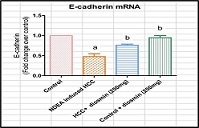Effect of Diosmin on The Expression of Epithelial-Mesenchymal Transition Signaling Molecules in Ndea-Induced Hepato-Cellular Carcinoma in Experimental Rats

Abstract:
References:
[1]
Bray, F., Ferlay, J., Soerjomataram, I., Siegel, R. L., Torre, L. A., and Jemal, A. 2018. Global cancer statistics
2018: GLOBOCAN estimates of incidence and mortality worldwide for 36 cancers in
185 countries. CA: A Cancer Journal for Clinicians. https://doi.org/10.3322/caac.21492.
[2]
Mittal, S.,
and El-Serag, H. B. 2013. Epidemiology of hepatocellular carcinoma:
consider the population. Journal of clinical gastroenterology,
47 Suppl(0):
S2–6.
[3]
Hanin, S. M.
A., Dharman, S., and Girija, A. S. S. 2022. Association of
salivary microbes with oral mucositis among patients undergoing chemoradiotherapy
in head and neck cancer: A hospital-based prospective …. Journal of International Oral Health. Retrieved from https://www.jioh.org/article.asp?issn=0976-7428;year=2022;volume=14;issue=1;spage=53;epage=60;aulast=Azima.
[4]
Bhoori, S., and Mazzaferro, V. 2014. Corrigendum to “Current challenges in liver transplantation for hepatocellular
carcinoma”.
Best Practice
& Research Clinical Gastroenterology,
28 (2014):
867–879.
https://doi.org/10.1016/j.bpg.2014.10.007.
[5]
Liberal, R.,
and Grant, C. R. 2016. Cirrhosis and autoimmune liver disease:
Current understanding. World journal of hepatology,
8(28):
1157–1168.
[6]
Blagotinsek,
K., and Rozman, D. 2017. Targeting Signalling
Pathways in Hepatocellular Carcinoma. Current pharmaceutical design,
23(1):
170–175.
[7]
Abijeth, B.,
and Ezhilarasan, D. 2020. Syringic acid induces apoptosis in
human oral squamous carcinoma cells through mitochondrial pathway. Journal of oral and maxillofacial pathology:
JOMFP, 24(1):
40–45.
[8]
Hu, T.H., Huang, C.C., Lin, P.R., Chang, H.W., Ger, L.P., Lin, Y.W.,Changchien, C.S., Lee, C.M., Tai,
M.H. 2003. Expression and prognostic role of tumor suppressor gene
PTEN/MMAC1/TEP1 in hepatocellular carcinoma. Cancer,
97(8):
1929–1940.
[9]
Sushma, B., Vishnu Priya, V., Karthik Ganesh, M., and Gayathri, R. 2020.
Awareness on risk factors associated with oral cancer among school students in chennai.
International
journal of current research and review, 12(24):
S–87–S94.
[10]
Sun, E. J., Wankell, M., Palamuthusingam, P., McFarlane, C., and Hebbard, L. 2021. Targeting the PI3K/Akt/mTOR
Pathway in Hepatocellular Carcinoma. Biomedicines.
https://doi.org/10.3390/biomedicines9111639.
[11]
Sivakumar, N., Geetha, R. V., and Priya, V. 2021. Gayathri R, Dhanraj Ganapathy.
Targeted Phytotherapy for Reactive Oxygen Species Linked Oral Cancer. Int J Dentistry Oral Sci,
8(1):
1425–1429.
[12]
Knowledge about the effects of medicinal plants against COVID-19 among dental
students-A questionnaire study. (n.d.). Retrieved from https://pesquisa.bvsalud.org/global-literature-on-novel-coronavirus-2019-ncov/resource/pt/covidwho-995148.
[13]
Karthik, E.
V. G., Priya, V. V., Gayathri,
R., Dhanraj, G.
2021. Health Benefits Of Annona Muricata-A
Review. Int J
Dentistry Oral Sci, 8(7):
2965–2967.
[14]
Lakshmi, T. (n.d.). Medicinal value and oral health aspects of acacia catechu-an
update. International
journal of dentistry and oral science.
[15]
Lewinska, A.,
Siwak, J., Rzeszutek, I., and Wnuk, M. 2015. Diosmin induces genotoxicity
and apoptosis in DU145 prostate cancer cell line. Toxicology in vitro: an international
journal published in association with BIBRA,
29(3):
417–425.
[16]
Perumal, S.,
and Langeswaran, K. 2020. Diosmin anti-tumour efficacious against
Hepatocellular Carcinoma. Research Journal of Pharmacy and Technology.
https://doi.org/10.5958/0974-360x.2020.00308.x.
[17]
Srinivasan,
S., and Pari, L. 2012. Ameliorative effect of
diosmin, a citrus flavonoid against streptozotocin-nicotinamide generated oxidative
stress induced diabetic rats. Chemico-biological interactions,
195(1):
43–51.
[18] Queenthy, S. S., and John, B. 2013. Diosmin exhibits anti-hyperlipidemic
effects in isoproterenol induced myocardial infarcted rats. European journal of pharmacology,
718(1-3):
213–218.
[19] Jayaraman, S., Krishnamoorthy,
K., Prasad, M., Veeraraghavan, V.P., Krishnamoorthy, R., Alshuniaber, M.A., Gatasheh,
M.K., Elrobh, M., and Gunassekaran. 2023. Glyphosate potentiates insulin resistance
in skeletal muscle through the modulation of IRS-1/PI3K/Akt mediated mechanisms:
An in vivo and in silico analysis. International
Journal Biological Macromolecules, 242(Pt 2):124917.
[20] Selvaraj, J., Muthusamy,
T., Srinivasan, C., and Balasubramanian, K. 2009. Impact of excess aldosterone on
glucose homeostasis in adult male rat. Clinic
Chimica Acta. 407(1-2):51-7.
[21]
Lafaro, K. J.,
Demirjian, A. N., and Pawlik, T. M. 2015. Epidemiology of hepatocellular
carcinoma. Surgical oncology clinics of North America,
24(1):
1–17.
[22]
Darvesh, A. S., and Bishayee, A. 2013. Chemopreventive and
Therapeutic Potential of Tea Polyphenols in Hepatocellular Cancer. Nutrition and Cancer.
https://doi.org/10.1080/01635581.2013.767367.
[23]
Santos, N. P., Colaço, A., da
Costa, R. M. G., Oliveira, M. M., Peixoto, F., and Oliveira, P. A. 2014. N-diethylnitrosamine
mouse hepatotoxicity: Time-related effects on histology and oxidative stress. Experimental and Toxicologic Pathology.
https://doi.org/10.1016/j.etp.2014.07.002.
[24]
Sakthisekaran, D. 2011. Resveratrol interferes with N-nitrosodiethylamine-induced
hepatocellular carcinoma at early and advanced stages in male
Wistar rats. Molecular Medicine Reports. https://doi.org/10.3892/mmr.2011.555.
[25]
Bishayee, A., Politis, T., and Darvesh, A. S. 2010. Resveratrol in the
chemoprevention and treatment of hepatocellular carcinoma. Cancer Treatment Reviews.
https://doi.org/10.1016/j.ctrv.2009.10.002.
[26]
Silvestro, L.,
Tarcomnicu, I., Dulea, C., Attili, N. R. B., Ciuca, V., Peru, D., and Savu, S. R. 2013. Confirmation of diosmetin
3-O-glucuronide as major metabolite of diosmin in humans, using micro-liquid-chromatography–mass spectrometry and ion mobility mass spectrometry. Analytical and Bioanalytical Chemistry.
https://doi.org/10.1007/s00216-013-7237-y.
[27]
Ali, T. M.,
Abo-Salem, O. M., El Esawy, B. H., and El Askary, A. 2020. The Potential Protective
Effects of Diosmin on Streptozotocin-Induced Diabetic Cardiomyopathy in Rats. The American Journal of the Medical
Sciences. https://doi.org/10.1016/j.amjms.2019.10.005.
[28]
Tanrikulu, Y.,
Şahin,
M., Kismet, K., Kilicoglu, S. S., Devrim, E., Tanrikulu, C. S., Erdemli,
E., Erel, S., Bayraktar, K., Akkus, M. A. 2013. The protective effect
of diosmin on hepatic ischemia reperfusion injury: an experimental study. Bosnian Journal of Basic Medical Sciences.
https://doi.org/10.17305/bjbms.2013.2305.
[29]
Tahir, M., Rehman, M. U., Lateef, A., Khan, R., Khan, A. Q., Qamar, W, Ali, F., O’Hamiza, O., Sultana, S. 2013. Diosmin protects against
ethanol-induced hepatic injury via alleviation of inflammation and regulation of
TNF-α and NF-κB activation. Alcohol. https://doi.org/10.1016/j.alcohol.2012.12.010.
[30] Carlson, B. A., Dubay, M. M., Sausville,
E. A., Brizuela, L., and Worland, P. J. 1996. Flavopiridol induces G1 arrest with inhibition of cyclin-dependent
kinase (CDK) 2 and CDK4 in human breast carcinoma cells. Cancer research,
56(13):
2973–2978.

